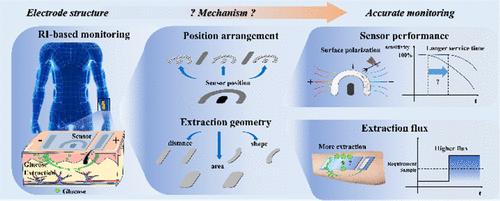电极结构对反向离子电泳监测葡萄糖的影响
IF 9.1
1区 化学
Q1 CHEMISTRY, ANALYTICAL
引用次数: 0
摘要
基于反向离子透入(RI)的连续血糖监测(CGM)为糖尿病治疗提供了一种有前途的无创解决方案。但在该技术的应用中,存在两个影响葡萄糖检测结果的关键问题:由于提取电流的影响,传感器灵敏度逐渐降低;葡萄糖提取通量不足影响了葡萄糖预测的准确性。我们发现电极结构对这两种类型的影响具有调节作用。然而,到目前为止,还没有全面或系统的研究电极结构在影响基于反向离子电阻的血糖监测的效率和准确性方面的作用。本研究通过多物理场模拟、体外实验和人体试验研究了电极结构对RI的影响。通过优化电极的空间布局、间距、形状和位置,使传感器灵敏度下降最小,葡萄糖提取通量最大。人体试验验证了优化设计,在临床上准确的Clarke误差网格A区域内实现了74%的数据点,平均绝对相对差(MARD)为13.17%,而之前的结构为62%和21.06%。这些发现突出了电极几何形状在提高基于ri的CGM精度方面的关键作用。本文章由计算机程序翻译,如有差异,请以英文原文为准。

Effect of Electrode Structure on Glucose Monitoring by Reverse Iontophoresis
Continuous glucose monitoring (CGM) based on reverse iontophoresis (RI) offers a promising noninvasive solution for diabetes management. However, in the application of this technology, there are two key issues that affect the glucose detection results: the sensor sensitivity is gradually reduced due to the influence of the extraction current; the insufficient glucose extraction flux affects the accuracy of glucose prediction. We found that the electrode structure has a regulatory effect on these two types of influences. However, to date, there was no comprehensive or systematic investigation into the role of electrode structure in influencing the efficiency and accuracy of reverse iontophoresis-based glucose monitoring. This study investigated the impact of electrode structure on RI through multiphysics simulation, in vitro experiments, and human trials. By optimizing the spatial arrangement, spacing, shape, and position of the electrodes, the sensor sensitivity decline was minimized and the glucose extraction flux was maximized. Human trials verified the optimized design, achieving 74% of data points within the clinically accurate Clarke error grid A zone, with a mean absolute relative difference (MARD) of 13.17%, compared to 62 and 21.06% for the previous structure. These findings highlight the crucial role of electrode geometry in enhancing the accuracy of RI-based CGM.
求助全文
通过发布文献求助,成功后即可免费获取论文全文。
去求助
来源期刊

ACS Sensors
Chemical Engineering-Bioengineering
CiteScore
14.50
自引率
3.40%
发文量
372
期刊介绍:
ACS Sensors is a peer-reviewed research journal that focuses on the dissemination of new and original knowledge in the field of sensor science, particularly those that selectively sense chemical or biological species or processes. The journal covers a broad range of topics, including but not limited to biosensors, chemical sensors, gas sensors, intracellular sensors, single molecule sensors, cell chips, and microfluidic devices. It aims to publish articles that address conceptual advances in sensing technology applicable to various types of analytes or application papers that report on the use of existing sensing concepts in new ways or for new analytes.
 求助内容:
求助内容: 应助结果提醒方式:
应助结果提醒方式:


